SwampTiger
Banned
Thanks McPherson! If France adapted the ASROC launcher to Exocet/Roland, we have a start.
IIRC no.
Unlike her half-sister Colbert it wasn't possible to fit Mascura to De Grasse because of the internal subdivision of the hull. So it wouldn't be possible to fit Terrier, Tatar or Sea Dart either.
The POD is late 60's or early 70's. Argentina did not inquire about Aspide until late 70's. The Terrier/Tartar/Sea Dart/Mascura are medium to long range SAMs. Roland/Sea Sparrow/Aspide are short range replacements for Bofors and similar guns. SM-1 appeared in early 80's.
In such a scenario, how long do you think would they operate the Alaskas? Considering the first-generation dreadnoughts they would probably replace were operated until the 1950s, I could see the Alaskas being operated until the 1980s or 90s.
My ideal, and unlikely choice, would be two squadrons of F-101C Voodoo with Exocet/AS-30/Roland adapted to the rotary weapons bay.
This thread, and the RN one from last week, has got me thinking about Area Defence SAMs of the era so I broke out my Jane's Fighting ships 1969-70 and found that in 1969-70 these navies had Area Defence SAM ships. This does not count navies who operated the likes of Sea Cat and might miss a ship or two.
In 1969-70 only the most advanced and professional navies had Area Defence SAM ships, mostly in very small numbers. In that case I think expensive Area Defence SAM upgrades for an Argentine ship procured in about 1968 isn't really on the cards.
- Australia 3
- France 6
- W Germany 3
- Italy 8
- Japan 1
- Netherlands 1
- UK 8
- USA 74
- USSR 21
More likely eats three-four Mark 8 Mod 4 fish from HMS Conquer instead of the old Brooklyn class CL General Bergrano and the rank stupidity of constructing a ship the size of a CB without proper underwater protection is exposed for all to see resulting the loss of 1/3 of the Argentine ship's crew.Most significantly, would there be a chance where an Alaska single handedly saves the Malvinas becoming one of the most celebrated and revered warships of modern times?
I haven't checked my reference books but IIRC Colbert could be fitted with an area defence SAM because she was designed with such a conversion in mind and De Grasse wasn't. AFAIK it was the internal layouts of both ships that made one possible and the other impossible.How is it different? I am not a fan of Masurca, too few platforms/operators. How does the entire mount/magazine/machinery differ/compare between Masurca and the Mk11/13 Tartar? I see the Masurca system weighs @ 450 metric tons, but have no info on dimensions.The four aft 127/54 1948 mounts of De Grasse/Colbert weighed 49 metric tons each. The mount could be moved more amidships if needed.
I think that is an excellent point. Argentina, if she is going to operate an austere aircraft carrier, needs at least one AAA bodyguard ship and 2 or 3 ASW bodyguard ships, even if the flattop is merely a sortie unit. If the aircraft carrier is at sea as a regular exercise, then double those requirements.
In 1969-70 only the most advanced and professional navies had Area Defence SAM ships, mostly in very small numbers. In that case I think expensive Area Defence SAM upgrades for an Argentine ship procured in about 1968 isn't really on the cards.
I think that is an excellent point. Argentina, if she is going to operate an austere aircraft carrier, needs at least one AAA bodyguard ship and 2 or 3 ASW bodyguard ships, even if the flattop is merely a sortie unit. If the aircraft carrier is at sea as a regular exercise, then double those requirements.
Argentina purchased Type 42's in 1970 and Iranian bought Badr with SM-1's in 1971, so I would not think it would be completely outrageous.
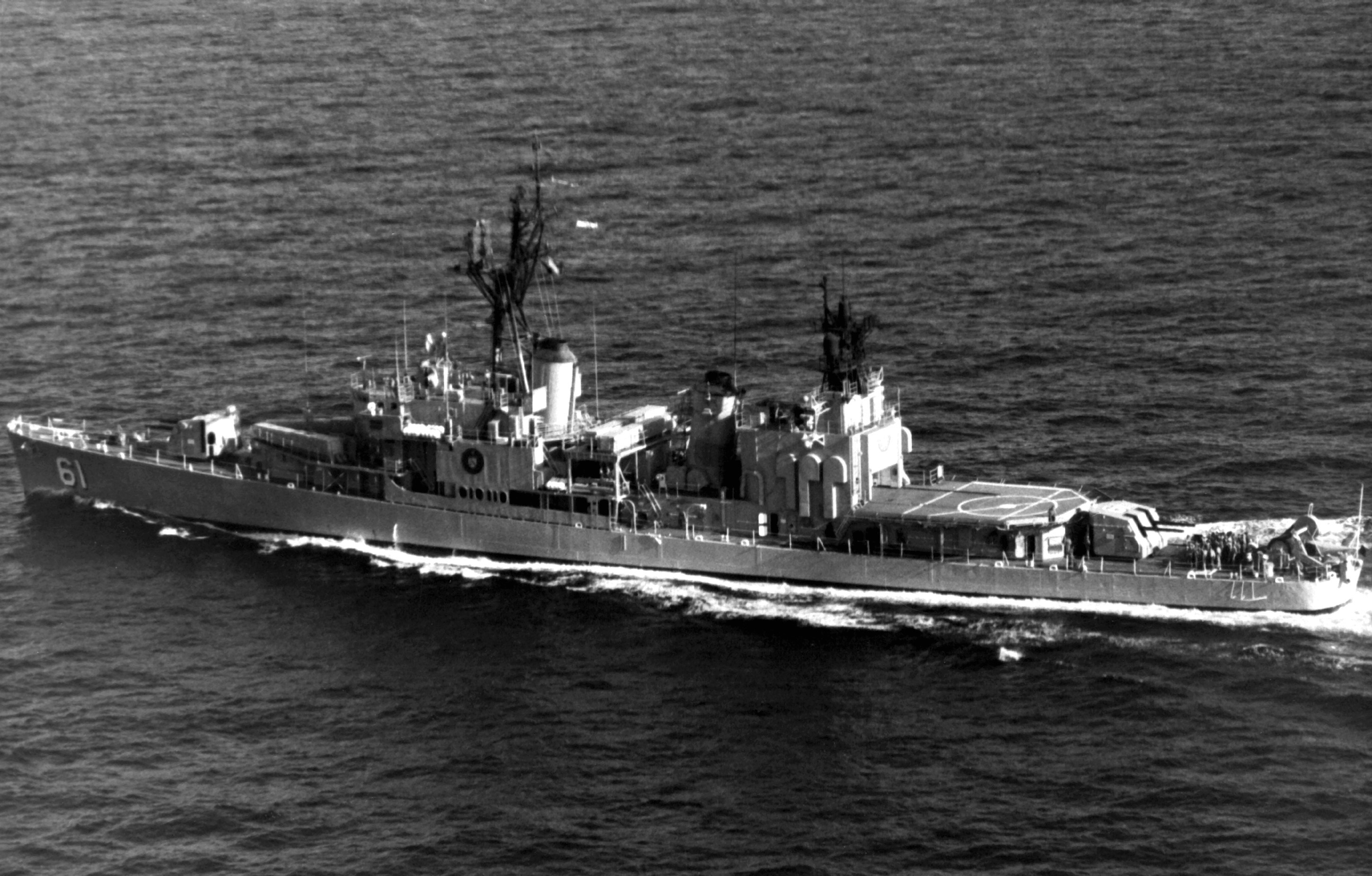
Argentina purchased Type 42's in 1970 and Iranian bought Badr with SM-1's in 1971, so I would not think it would be completely outrageous.
This sensible comment brings out a different question, without any significant background knowledge. Could Argentina acquire more modern US gear if it decides to put it's primary effort into ASW, ie. helping out USN against Soviet and possible Soviet allies in South Atlantic? By 1960's onwards ASW capable ships are, after all, many times multi-role combatants, and much of the gear suitable for ASW use, such as LRMPA, is also very useful against Chile or an unnamed European power.

The Babrs are an interesting example as they were ex USN WW2 destroyers with Standard SM1, but these were not in a Mk 11/13/22 launcher with the Tartar Guided Missile Fire Control System coupled to extensive radars. Rather they were in 4 paired elevating box-type launchers, and I am unsure how they were guided. However it does fit the Argentine requirement of wanting a ship and getting it almost immediately like they did with de Mayo.
The Sumner class upgraded for Iran
The refits were done together at Philadelphia Naval Shipyard. Besides the systems below, the hulls were cleaned and refurbished. All systems related to the defunct DASH project were deleted. The air conditioning system was greatly improved and expanded, and dust filters were fitted. The crew berthing arrangements were slightly altered to suit Iranian organization. The crew was now 14 officers and 276 enlisted.

(IIS Babr and IIS Palang in drydock at Philadelphia, PA during 1973; in the midst of the pre-transfer conversion.)
Surface-to-Air Missiles
For these WWII-veteran destroyers, their new mission was to be air defense. Iran was not the only country to mount “SAMs-in-a-box” aboard WWII-veteran ships, but it was certainly not a common set-up as it had many limitations.
The RIM-66 Standard surface-to-air missile (SAM) entered US Navy service in the late 1960s as a replacement for RIM-24 Tartar. The RIM-66 weighed 1,558 lbs and was 15’6″ long, flying at Mach 3.5. The version supplied to Iran had a maximum range of 18NM and a minimum range of 2NM. The Standard had a Mk51 137 lbs fragmentation warhead.

(The RIM-66 Standard surface-to-air missile (SAM) as exported to Iran with the refit WWII destroyers. In the foreground is the nose of a RIM-24 Tartar which Standard replaced in American service, and in the background is a RGM-64 Harpoon ship-to-ship missile which was also sold to Iran for use on other warships.)
The coffin-style Mk32 Mod2 launcher system weighed 11 tons and consisted of a one-round launcher 17′ long and a one-round reload box of equal length in front of it. This very simplistic launcher had few parts and was a “bolt-down” item requiring few alterations to the ship itself. The “coffin” door took several seconds to open prior to firing, and to reload it from the box the door had to be closed then re-raised. Once both the launcher and box were empty, they could only be refilled pierside in port.
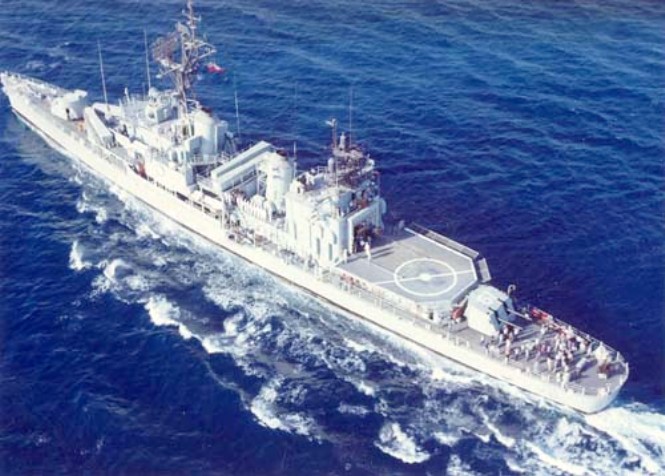
(IIS Babr showing the four Mk32 Mod2 launchers, two amidships and two in front of the bridge. The pairs were oriented opposite directions with their reload box in front of them.) (photo via navsource.org website)
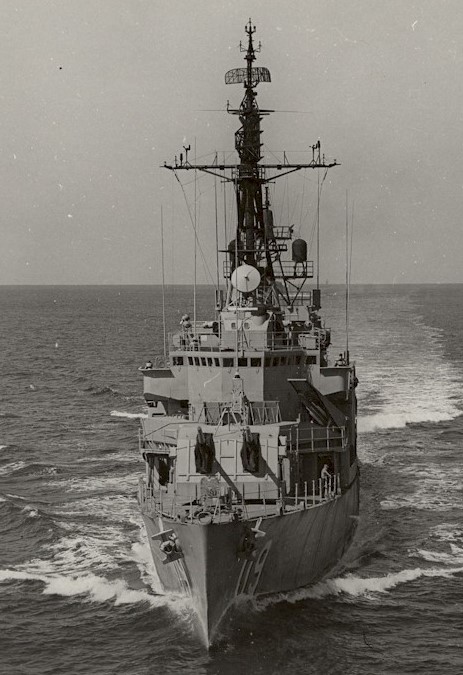
(The port-side forward launcher on IIS Palang opened and elevated with a missile ready.)
Compared to a normal swinging, elevating missile launcher with below-decks magazine, there was no real advantage to the Mk32 Mod2 other than it was the only arrangement which would work on the WWII-era hulls.
The Standard SAMs did not have to be pointing dead-on towards the target at the moment of launch, however, they had to be reasonably oriented towards it. Normally with a regular naval SAM system, the launcher would just rotate towards the threat direction, but with Babr and Palang, the whole destroyer might have had to maneuver.
The biggest handicap was the fire control system. The SAMs were guided by one Mk25 radar. (This radar was also the aiming system for the 5″ guns.) The Mk25 was seated atop the WWII Mk37 director and as such, to point the dish in a certain direction the whole physical steel structure had to be rotated, wasting precious seconds. The Mk25 could only guide one RIM-66 at a time, and even if the SAM missed, the Mk25 was occupied with it during it’s entire flight. The fire control system was a hodge-podge of WWII-era and Cold War-era components originally intended for aiming WWII guns and not for guiding a modern missile.
One issue was that Iran’s future foe, Iraq, was modernizing at a much faster pace than envisioned in the early 1970s when Iran began studies on obtaining these ships. At that time, the Iraqi air force was still flying mediocre-performance planes with basic free-fall bombs. But by the early 1980s, the Iraqi air force had moved up to the supersonic Mirage F.1 and MiG-23 “Flogger”. At 800′ altitude, a Mirage traveling Mach 1 moves about a quarter-mile every second. The time between the plane entering the RIM-66’s envelope and it being right on top of the destroyer was only about eighty seconds. Given all the issues with the coffin-launcher arrangement and director, most likely the destroyer would only be able to get off one, maybe two, missiles.

(The scourge of merchant sailors in the Persian Gulf during the 1980s, an Iraqi Mirage F.1 with AM.39 Exocet anti-ship missile.)
There was (and to a degree, still is) a lot of confusion about the missiles on these two Iranian ships. The 1976 edition of Combat Fleets Of The World incorrectly listed them as RIM-24 Tartars. Other sources in the 1980s incorrectly claimed they were AGM-78 Standard-ARM weapons, an anti-surface radar-homing version of the RIM-66.
Despite all these issues, the introduction of RIM-66 into the Imperial Iranian fleet was a milestone and gave it at least something of a long-range anti-air ability, at a time when most of the other Arab navies were still limited to obsolete manually-aimed guns. Additionally, the missiles could be fired (at short ranges) in a ship-to-ship mode.
Other weapons
The gun armament remained the original WWII Mk38 twin 5″ guns, of which only two turrets remained. Despite it’s age and obsolescence by the 1970s, in the right circumstances this could still be a punishing gun. Even in the 1970s, the USA still retained huge stockpiles of WWII and Korean War era ammunition for this gun, so at the time that was not viewed as a problem. Each destroyer carried 422 rounds of 5″ ammunition.
The Mk38s were the only gun armament specified by Iran. All WWII-era 40mm, 20mm, and .50cal weapons had already been removed during the FRAM II project and quite frankly, the Iranians didn’t envision much need for gunfire given the destroyers new duty of SAM firers.

(The forward Mk38 mount on IIS Babr during the 1970s.)
Two triple Mk32 torpedo tubes were carried amidships. These fired Mk46 ASW homing torpedoes which had a range of about 2 ½ – 3 NM. The Mk46 torpedoes were expensive and also required American technical support to calibrate and maintain in storage. Aboard the destroyers, each of the six tubes had one reload however as the set-up had been shoehorned onto the WWII hulls, reloading required manual transportation of the torpedoes on deck and would have been difficult in combat.
Surprisingly, Iran ordered the shipyard to reinstall the old WWII-era Mk11 Hedgehogs. Now almost 35 years old, these old ASW weapons designed to fight German u-boats were of very limited use against modern submarines. The Hedgehogs were reinstalled in their original WWII location, beneath the bridge wings on the former “B” gun deck which now housed the forward two RIM-66 launchers and reload boxes.
Helicopter
Iran ordered removal of the DASH hangar. In it’s place, a Canadian-designed helicopter hangar with telescoping extension was installed and the helipad enlarged.
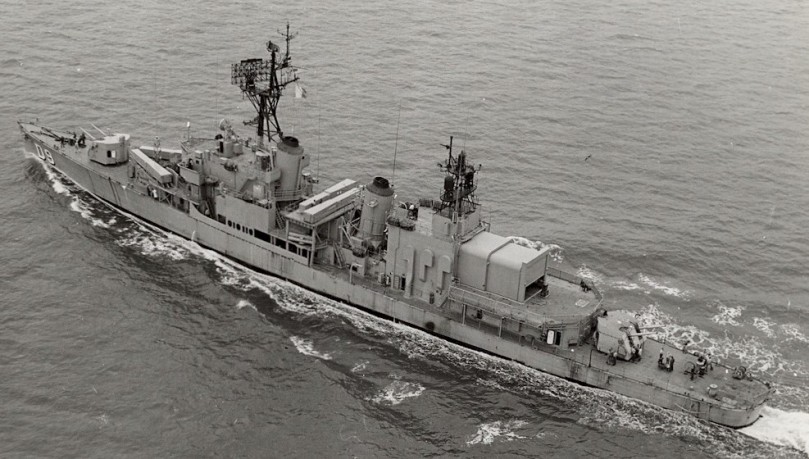
(IIS Palang showing the Canadian-designed hangar extension telescoped out.)
Before the 1979 revolution, the Iranian navy bought six AB-212AS anti-submarine helicopters in a deal separate from the destroyers. This was a twin-engine naval version of the UH-1 Iroquois license-made in Italy. This was the helicopter type Babr and Palang carried.
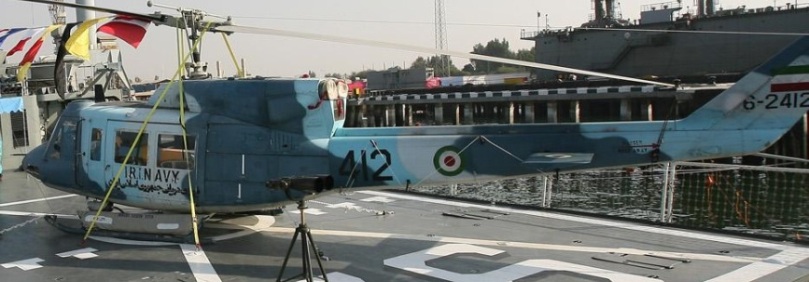
(AB-212AS of the Iranian navy in post-1979 era markings.)
Radars
The Westinghouse AN/SPS-29C radar was a key component to the Iranians. This radar had a 18’x11′ antenna, which was a cleverly-designed dipole folded in on itself. It had an instrumented maximum range of 270NM. Realistically, against a large plane at high altitude the maximum was 243NM. Against a modern fighter at medium or low altitudes, the typical detection range was between 50-100NM. Like most naval radars of it’s generation, performance fell off at very low altitudes and an incoming sea-skimming missile like Harpoon or Exocet could only be detected between 6-11NM, by which point it would probably be too late to do anything about it. Iran ordered installation of the AN/SPA-52 processor during the Philadelphia refit. This gave an added ship-to-ship function out to about 15NM. The AN/SPS-29C rotated a beam 25°x20°. A limitation was that it could not determine the detected plane’s altitude.
Besides the primary role of long-range warning for the destroyer itself, Iran envisioned the AN/SPS-29C as being an area asset, providing coverage for other nearby warships. In the western Persian Gulf, it’s coverage would reach into Saudi Arabia, Qatar, and the UAE; detecting warplanes from those countries before they even left their own airspace.
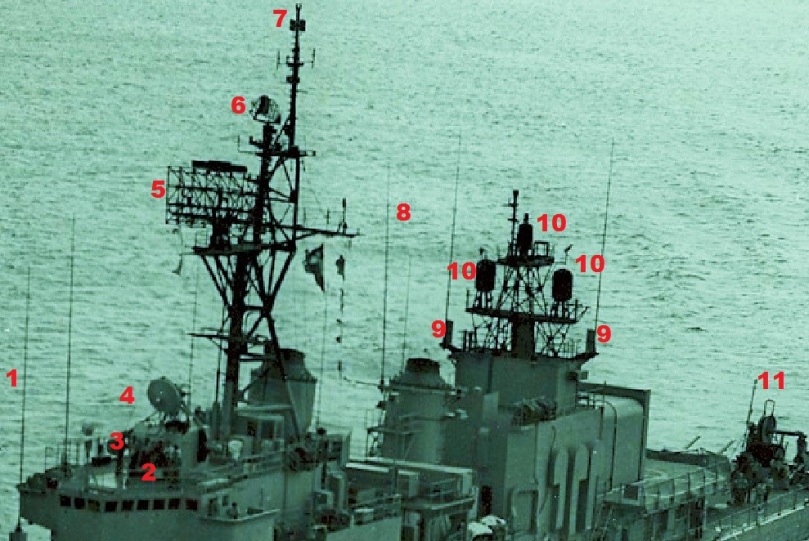
(Sensors aboard the two Iranian Sumner class destroyers: 1: combined broadband radio antenna 2: location for AN/SPS-59 not yet installed 3: Mk37 director 4: Mk25 radar 5: AN/SPS-29 radar 6: AN/SPS-10 radar 7: AN/UPX-12 IFF 8: AN/URC-32 radio antenna 9: AN/ULQ-6 jammers 10: AN/WLR-1 ESM 11: AN/SQA-10 VDS)
The AN/SPS-10 was a general-duty workhorse radar of the US Navy throughout the Cold War. It’s primary role was surface search.
The AN/SPS-59 navigation radar was added after the ships were already in Iran. This was a short-range radar based on the commercial LN-66.
The Mk25 radar was mounted on top of the WWII-era Mk37 gunnery director, where the old Mk12 radar had been during WWII. This radar was the “eyes of the guns”, calculating range and bearing. It was also the target illumination system for the RIM-66 Standard SAMs.
Sonars
The sonar system was upgraded to Iran’s request. The WWII-era QGA hull sonar had already been replaced in US Navy service by the AN/SQS-4. By the 1970s this itself was obsolete and Iran ordered AN/SQS-43 on Babr and AN/SQS-44 on Palang. Both of these hull sonars were very similar and both had a range of about 4NM. Most likely, Iran was hedging it’s bets against one or the other having an unforeseen problem, which neither did. Both interfaced directly with the ASW torpedoes through a Mk105 targeting computer. These sonars were at least a generation behind the top-line American systems of the 1970s, but were better than most developing-country navies had, and much better than the mediocre sonars the Soviets were exporting to their allies at the time.
Both, but especially AN/SQS-44, could perform directional transmissions, blasting the “ping” out down a certain bearing instead of all around. These were (at that time) the most advanced sonars carried on any WWII-era Sumner or Gearing worldwide. None of the other Persian Gulf navies even had submarines so clearly the Iranians were looking to use these destroyers against the Soviets in the open waters of the Indian ocean.
Both destroyers carried the AN/SQA-10 variable-depth sonar. Carried on the stern, it towed an AN/SQS-31 sonar transducer behind the ship. A VDS allowed the destroyers to detect submarines beneath the thermocline, a layer in the ocean where temperature and pressure changes refracts sound. For the 1970s, this was a sophisticated sensor for a “third world” navy to have. In the shallow Persian Gulf, a VDS is useless so it was clearly intended for open-water use in the Indian Ocean.
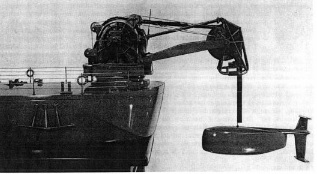
(Scale model of the AN/SQA-10 with the towed transducer, as exported to Iran on these two destroyers.) (official US Navy photo)

(IIS Babr showing the VDS in it’s stowed configuration and the helicopter hangar extension retracted.)
Electronic warfare systems
The FRAM II electronic warfare suite, AN/WLR-1 ESM and AN/ULQ-6 jammers, were retained. The AN/WLR-1 system was a “quiet” sensor in that it did not emit any signal, rather it intercepted enemy radars and classified the source; and in certain circumstances could even determine the emitter’s bearing.
Iran installed the AN/UPX-12 IFF system, which automatically “interrogated” air or sea contacts to determine if they were friendly or not. This system would also allow the Imperial Iranian destroyers to operate alongside US Navy forces.
The radio fit included AN/GRC-27 and AN/URC-32, and the destroyers could easily communicate not only with other Imperial Iranian warships but also US Navy vessels.
IIS BABR
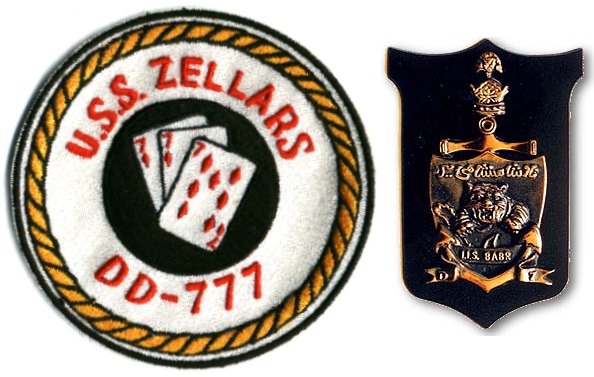
(Crests of USS Zellars / IIS Babr)
IIS Babr was formerly USS Zellars (DD-777), a Sumner class destroyer commissioned on 25 October 1944. During WWII, USS Zellars participated in the Okinawa battle where the destroyer was hit with a bomb and a B6N “Jill” kamikaze. USS Zellars missed the rest of WWII as the damage was repaired. During the Korean War, USS Zellars participated in the Wonsan and Hungnam battles. In 1960, USS Zellars completed the FRAM II modernization. The old destroyer ended her US Navy career as a training ship, decommissioning on 19 March 1971 and then placed into storage at the Philadelphia inactive ships facility.

(USS Zellars after the FRAM II upgrade. All of the WWII light AA guns and WWII torpedo banks are gone. Less the changes described earlier, this was more or less the basic structural layout of the ships at the time of sale. The little object in the sky is the QH-50 DASH heli-drone.)
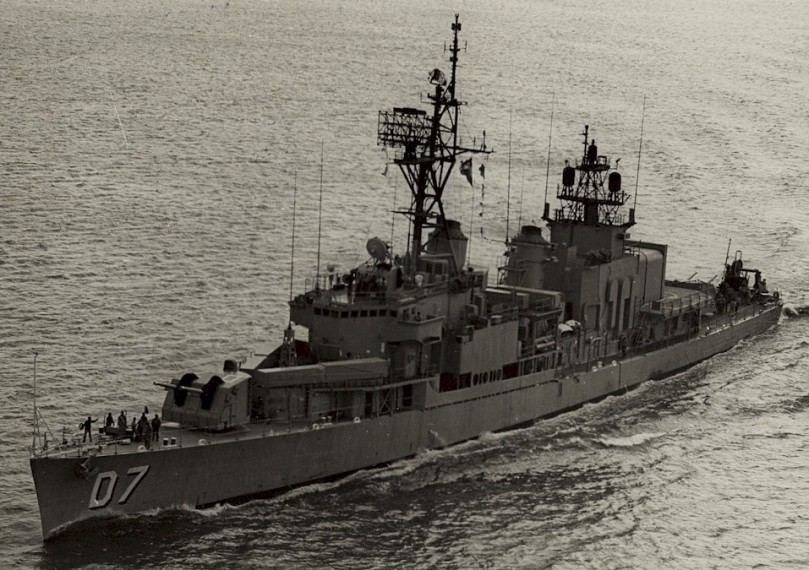
(IIS Babr in Imperial Iranian service.)
IIS Babr inherited the name of a gunboat sunk during WWII as part of the Anglo-Soviet invasion of Iran. The original pennant number was D-7, changed to D-61 after the 1979 revolution.
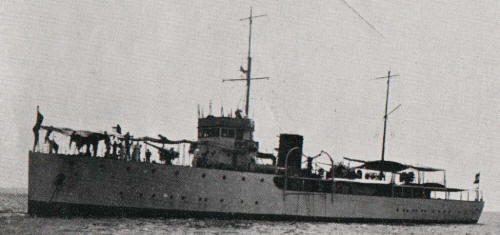
This sensible comment brings out a different question, without any significant background knowledge. Could Argentina acquire more modern US gear if it decides to put it's primary effort into ASW, ie. helping out USN against Soviet and possible Soviet allies in South Atlantic? By 1960's onwards ASW capable ships are, after all, many times multi-role combatants, and much of the gear suitable for ASW use, such as LRMPA, is also very useful against Chile or an unnamed European power.
The Type 42 is a later and arguably better ship than the Charles Adams Class. I think there is not much to choose between the air defense systems circa 1980, but I certainly think the British ship has a better ASW capability than even the IKARA armed Australian Perth class.
The best near peer comparison is that it was mission akin to an Oliver Hazard Perry's role. And here I think the Type 42 has a most decided edge.
If one thinks the RN was in a hurry to refit Type 42s after Falklands Lessons Learned, one should have seen the USN scurry. In a sense the Argentine air force did NATO a favor and showed its navies in the nick of time what the new Russian cruise missiles just coming into service would do.
While the Argentine Navy could (and probably should) have invested more heavily into ASW, replacing a carrier fleet with an escorts only surface fleet wouldn't meet it's expected use unless some war in the late 1950s or early 1960s ends up with carriers sunk by submarines.This sensible comment brings out a different question, without any significant background knowledge. Could Argentina acquire more modern US gear if it decides to put it's primary effort into ASW, ie. helping out USN against Soviet and possible Soviet allies in South Atlantic? By 1960's onwards ASW capable ships are, after all, many times multi-role combatants, and much of the gear suitable for ASW use, such as LRMPA, is also very useful against Chile or an unnamed European power.
While the Argentine Navy could (and probably should) have invested more heavily into ASW, replacing a carrier fleet with an escorts only surface fleet wouldn't meet it's expected use unless some war in the late 1950s or early 1960s ends up with carriers sunk by submarines.
The Argentine Navy at that point in time is focusing in war with Chile or Brazil first. ASW capabilities, while needed, don't replace the capacity to strike at either country' surface combatants or coasts.